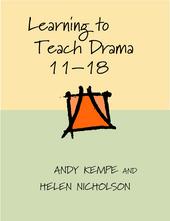Why Singapore’s English Teachers Should Embrace Singlish, Not Fight It
Is it time for Singaporean educators to embrace Singlish as a legitimate learning tool? What the Research […]
Read More
Andy Kempe and Helen Nicholson (2001), Continuum, ISBN 0826448410, 240 pages

Drama provides an effective approach to fostering learning as provides an interactive experience, and any form of good learning should include experiential learning, which can be attained through interactive collaboration (Sawyer, 2003).
Drama affords a good vehicle for learning as it blends performance and experience, and thus allows students to explore a range of possibilities in daily human life through re-enactment and reflection.
For example, the tension in human relationships explored in drama education simulates real-life challenges and develops the emotional strength in decision making.
The history of drama education is well documented in this book, beginning with the publication of Dramatic Methods of Teaching by Findlay-Johnson in Britain in 1911 (p. 34). A strength of this book lies in its inclusion of information and communications technology (ICT) as part of the support for drama education (pp. 29-30). This adds currency to the century-old approach to education.
Drama education is an entity of conventions. Students and teachers need to respect the convention and maintain a contract of the dramatic process. On the teacher’s part, there is a need to frame motivating questions and awaken the pupils’ interest; and on the pupils’ part, there has to be an element of play that makes them want to be part of the dramatic art.
The book not only provides important ideas on how to conduct a drama lesson, but also clear instructions on how all aspects of the dramatic process should be taken care of, such as managing mischief in the classroom, assessing participation in drama education, and even practical tips on preparing a checklist for a class outing to a drama performance.
“Pupils have the right to express their own feelings and beliefs. However student-teachers need to consider what they propose to do when those beliefs turn out to be sexist, racist or…offensive… What must be separated…is the dramatic representation of beliefs…and the unmitigated expression of the pupils’ own beliefs.” (p. 101)
The chapters are carefully arranged with the beginning teacher in mind, starting with the preliminary moments of exploring whether to be a drama teacher, and progressing to more sophisticated reading. The book also includes a chapter on drama assessment. The further readings supply additional information for those who want to advance the craft of drama education.
The challenge for drama teachers in Singapore is to sustain the use of drama education in the classroom, especially since it is not a stipulated subject in the curriculum. The authors help readers understand that the debate over drama as a subject versus drama as an approach is rather unfounded and indeed unnecessary.
I recommend this book as foundational reading for teachers contemplating the use of drama as an educational approach in school. I have certainly benefited from it.
References
Sawyer, R. K. (2003). Group creativity: Music, theater, collaboration. Mahwah, NJ: Lawrence Erlbaum Associates.
Stinson, M. (2004). Drama: Supporting learning in project work. In H. B. Tiong, J. Netto-Shek, & A. S. C. Chang (Eds.), Managing project work in schools: Issues and innovative practices (pp. 210-220). Singapore: Pearson Education South Asia.